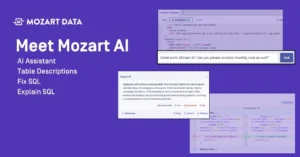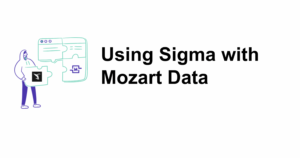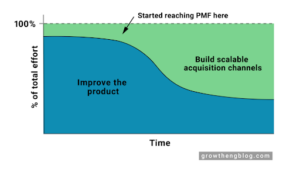TL;DR:
- Data integration is the process of connecting data sources, either through loose coupling or tight coupling methods.
- Tight coupling, using data integration and transformation tools, moves all data into a single storage location, improving analytics and data observability.
- Data transformation involves changing the formatting, values, or structure of data for various purposes.
- The best data integration tools ensure orderly data transfers and maximize resources.
- Choosing the right data integration and transformation tool, such as Mozart Data, can greatly improve data quality and provide support for ongoing maintenance and upgrades.
When connecting data between modern applications, it’s easy to fall into a data integration trap.
Built with maximum connectivity in mind, applications can share data with each other via an API or webhook. While this loose coupling method integrates data, it also results in poor analytics, a lack of data observability, and a web of data that is hard for end-users to access.
Break free of this tangled web of data by instead using a tight coupling method with data integration and transformation tools. Compared with a loose coupling which allows data to reside in its original applications, a tight coupling strategy moves all data into a single storage location, a data warehouse.
A tight strategy offers a more curated, accessible, and actionable collection of data that you can use to run operations or build analytics. It uses dedicated software integration tools to bring order to your data stack. In this approach, the data warehouse becomes a single authoritative source of truth for all data needs. From there, you can conduct bulk transformations on your data and share it with users and applications.
The main benefit of a loose coupling design is that it’s so easy to set up initially, you can do it without even realizing you’re using a data strategy. But this benefit isn’t worth getting excited for because the best data integration tools in a tight strategy offer out-the-box connectivity that’s just as easy, enabling you to connect new data sources in a few clicks.
What is data integration?
Data integration is the process of connecting data. It can be a loose coupling/federated connection like the connecting apps through webhooks or it can be a tight coupling of data sources in which all data is replicated and connected in a single OLAP data cube or data warehouse. In tight coupling scenarios, it becomes important to use data transformation tools to fit data together after it is centralized.
What is data transformation?
Data transformation is changing the formatting, values, or structure of data for any purpose. It can involve deduplicating data, standardizing values, or adding placeholders for null values to prevent processing errors. It can also involve structurally connecting data tables together in data integration use cases.
Data integration and transformation tools
The tools for connecting data can range from basic open-source data integration tools that simply ship data to proprietary data sharing tools such as an enterprise service bus (ESB) from Oracle.
It’s important to note that data integration and transformation tools can be combined, making building a data pipeline more elegant and efficient. Notable examples of combined integration and transformation are in ETL tools such as Hevo Data, Talend Open Studio, and Mozart Data.
Data integration tools
Unlike the loose approach where data sources are connected with no real intermediary, in a tight data integration strategy, there is a need for data integration tools that power the process. By bringing data together, users can eliminate data silos – an instance in which data analysis is limited by the inability to access data. By centralizing data in a single location, users no longer need to make multiple authorization requests to get the data they need.
The best data integration tools ensure that transforms and data transfers are carried out in an orderly fashion, maximizing resources and aggregating data in a way that meets your needs. This can mean batch-processing data during off-hours or providing streaming data updates.
Data transformation tools – ETL vs. ELT
ETL tools are a well established group of data integration tools with a history dating back to the 1970’s. Standing for extract, transform and load, ETL tools include data transformation as part of the process of moving data from one location to another. With the rise of cloud data warehouses, a new paradigm of ELT emerged which leverages cloud storage to delay the transformation step until after data is centralized.
The advantage of ETL is that it creates data that is ready to use for analytics. The advantage of ELT is that it allows you to start collecting data right away and add new transforms and queries as you need them.
The best data transformation tools give you flexibility to choose between transforming data as you pull it from its sources (ETL) or also let you conduct transforms on data after it is loaded into a data warehouse (ELT).
The best data integration and transformation tools
When integrating data, the most important consideration is choosing a tool that integrates all your data sources. Mozart Data is one of the leading ETL tools in this regard, with over 500 data connections.
If those 500+ data connections aren’t enough, Mozart partners with Portable.io which can craft customer data connectors to ensure that all of your most important data sources are connected.
While you may hire a dedicated architect to help set up your system that runs using free ETL tools, that expert won’t be around when problems arise. With Mozart, you have dedicated maintenance and support experts who share expertise that keeps your data pipeline running smoothly and can continue to provide support and suggestions for ways to improve and upgrade.
Built around ultimate customization, Mozart Data leverages an SQL Editor to enable users to write custom SQL queries to design data integration steps and transformations. This data transformation layer supports engaging with data creatively after it has been collected in a data warehouse.
To find out more about Mozart and see a data integration and transformation tools list, visit our page on integration tools and techniques.


